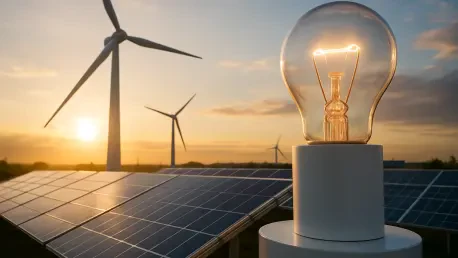In a groundbreaking move to transform the energy sector, the U.S. Department of Energy (DOE) has committed over $35 million to fuel 42 innovative projects under the Technology Commercialization Fund (TCF) for the current fiscal year, aiming to accelerate the journey of cutting-edge technologies from laboratory research to practical, market-ready solutions. Targeting pivotal areas such as artificial intelligence (AI), grid security, nuclear energy, and advanced manufacturing, the DOE aims to address some of the most pressing challenges in energy production and management. Beyond the financial injection, this initiative fosters a vital connection between national laboratories and private sector partners, ensuring that novel ideas translate into real-world impact. With an additional $21 million in cost-sharing from public and private entities, the scope and influence of this funding are significantly enhanced, promising to create waves of innovation throughout the energy landscape and positioning the U.S. as a frontrunner in global energy advancements.
Targeting Critical Energy Challenges
The DOE’s strategic allocation of funds through the TCF zeroes in on a diverse array of technologies essential for meeting both immediate and long-term energy demands. Key focus areas include AI and grid security, reflecting the pressing need for intelligent systems to manage increasingly complex and interconnected energy networks while safeguarding them against cyber threats. Additionally, the emphasis on nuclear energy signals a renewed commitment to sustainable, low-carbon power sources that can play a significant role in combating climate change. Advanced manufacturing, another priority, seeks to enhance industrial efficiency and minimize environmental footprints, aligning with broader sustainability objectives. This multifaceted strategy underscores the DOE’s recognition that modern energy challenges are intricate and interwoven, requiring a comprehensive approach to innovation that tackles multiple fronts simultaneously and ensures resilience in the face of evolving global demands.
Complementing this targeted approach, the funding initiative demonstrates a clear understanding of the interconnected nature of energy systems and the necessity for diverse solutions. By investing in AI, the DOE aims to harness data-driven insights to optimize energy distribution and predict potential disruptions before they occur. Meanwhile, the focus on grid security addresses the vulnerabilities exposed by an increasingly digital infrastructure, prioritizing robust defenses against potential attacks. Nuclear energy investments highlight a shift toward reliable, large-scale alternatives to fossil fuels, while advanced manufacturing initiatives strive to revolutionize production processes to be both cost-effective and eco-friendly. Together, these efforts illustrate a forward-thinking vision that not only responds to current energy needs but also anticipates future hurdles, ensuring that technological advancements keep pace with the evolving landscape of global energy consumption and environmental responsibility.
Nurturing the Next Generation of Energy Innovators
Among the standout efforts supported by this funding is the America’s Cradle to Commerce (AC2C) program, spearheaded by Lawrence Berkeley National Laboratory. Building on a proven track record of success from its earlier iteration, AC2C is dedicated to empowering startups by providing critical resources to bridge the often daunting gap between conceptual innovation and market deployment. This initiative offers technical de-risking support, helping early-stage companies navigate uncertainties that frequently deter investors and hinder progress. By creating a nurturing environment for these fledgling enterprises, the DOE ensures that promising ideas in the energy sector are not lost to practical challenges but instead have a viable path to commercialization, potentially transforming niche concepts into industry-changing solutions that address real-world energy problems.
Furthering this mission, the AC2C program exemplifies the DOE’s commitment to fostering entrepreneurship as a cornerstone of energy innovation. By equipping startups with the tools and expertise needed to refine their technologies, the initiative reduces the financial and technical barriers that often stall progress in the early stages of development. This support is crucial for attracting private investment, as it builds confidence in the viability of new energy solutions. Beyond individual company growth, AC2C contributes to a broader ecosystem of innovation by cultivating a pipeline of fresh ideas and talent that can drive the energy sector forward. This focus on empowering the next generation of innovators ensures that the U.S. remains a hub for groundbreaking advancements, with the potential to influence energy practices on a global scale through the successful scaling of homegrown technologies.
Bridging the Gap Between Research and Market
Another noteworthy project under the TCF funding is the enhancement of the Visual Intellectual Property Search (VIPS) tool to its 2.0 version, led by the Pacific Northwest National Laboratory. This platform is designed to simplify the process for businesses, researchers, and entrepreneurs to explore and license cutting-edge innovations originating from national laboratories. By improving access to a wealth of intellectual property, VIPS 2.0 serves as a critical conduit for transferring technology from research settings to commercial applications. This initiative not only democratizes access to high-caliber innovations but also accelerates the pace at which new solutions can be adopted in the marketplace, ensuring that the fruits of laboratory research reach those who can implement them effectively to solve pressing energy challenges.
In addition to enhancing accessibility, the upgraded VIPS tool underscores the DOE’s broader goal of streamlining the commercialization process for energy technologies. By creating a user-friendly interface that connects innovators with potential partners, the platform reduces the friction often encountered in technology transfer, making it easier for small businesses and larger enterprises alike to tap into groundbreaking research. This increased visibility of available technologies fosters collaboration across sectors, encouraging diverse applications of lab-developed solutions. The impact of such a tool extends beyond individual projects, as it builds a more interconnected innovation ecosystem where ideas can flow freely from conception to implementation, ultimately driving efficiency and progress in the energy industry through a more cohesive and accessible network of resources.
Securing a Competitive Edge on the Global Stage
Energy Secretary Chris Wright has articulated that this substantial financial commitment transcends mere funding—it represents a deliberate strategy to fortify America’s energy future while maintaining a leading position in the global arena. By supporting projects that challenge the boundaries of science and technology, the DOE is cultivating a portfolio of innovations with the potential to redefine energy paradigms worldwide. This vision is deeply aligned with the TCF’s mission to deliver breakthroughs that carry significant implications not just domestically but internationally as well. The emphasis on pioneering advancements ensures that the U.S. remains a pacesetter in energy innovation, influencing global standards and practices while addressing critical issues like energy security and environmental sustainability with cutting-edge solutions.
Moreover, this strategic investment signals a proactive stance in an increasingly competitive global energy landscape. By prioritizing transformative technologies, the DOE aims to establish benchmarks that other nations may follow, reinforcing American leadership in setting the agenda for future energy developments. This approach also serves as a catalyst for international collaboration, as successful innovations can inspire partnerships and knowledge-sharing across borders. The focus on maintaining a competitive edge is evident in the selection of projects that promise not only to solve immediate energy concerns but also to anticipate emerging trends, ensuring long-term relevance. Such foresight positions the U.S. to navigate global challenges effectively, leveraging technological superiority to influence policy and drive collective progress toward a more sustainable and secure energy future.
Fostering Collaboration for Lasting Impact
Central to the success of the TCF initiative is its emphasis on forging robust partnerships between public and private sectors, a model that ensures innovations are both developed and adapted to meet real-world market needs. The collaborative framework, bolstered by the additional $21 million in cost-sharing from diverse partners, maximizes the reach and efficacy of the DOE’s investment. This cooperative dynamic accelerates the transition from theoretical research to practical application, as it aligns technological advancements with industry demands. By uniting national laboratories, private companies, and other stakeholders, the DOE is championing a team-oriented approach to solving complex energy challenges, demonstrating that collective effort is paramount in achieving sustainable and impactful outcomes.
Expanding on this collaborative ethos, the TCF’s structure highlights the value of shared responsibility in driving energy innovation forward. Public-private partnerships not only pool financial resources but also blend diverse expertise, fostering an environment where ideas can be refined through multiple perspectives. This synergy is vital for ensuring that technologies are not only cutting-edge but also practical for widespread adoption, addressing both technical feasibility and market viability. The DOE’s leadership in orchestrating these alliances sends a powerful message about the importance of unity in tackling global energy issues, setting a precedent for how strategic collaboration can yield results that benefit society at large. As these partnerships flourish, they lay the groundwork for a resilient innovation ecosystem capable of sustained progress over time.
Reflecting on a Visionary Step Forward
Looking back, the DOE’s allocation of over $35 million through the TCF marked a defining moment in the pursuit of energy innovation. This investment across 42 diverse projects addressed critical domains like AI, grid security, nuclear energy, and advanced manufacturing, showcasing a holistic strategy to strengthen the nation’s energy infrastructure. Initiatives such as AC2C and VIPS 2.0 stood out for their roles in supporting entrepreneurship and enhancing technology access, while public-private collaborations amplified the impact through shared resources. Moving forward, stakeholders should prioritize scaling these innovations by fostering further partnerships and exploring additional funding avenues to sustain momentum. Policymakers and industry leaders must also focus on integrating these advancements into broader energy strategies, ensuring that the groundwork laid by this funding continues to inspire transformative change on a global scale.









